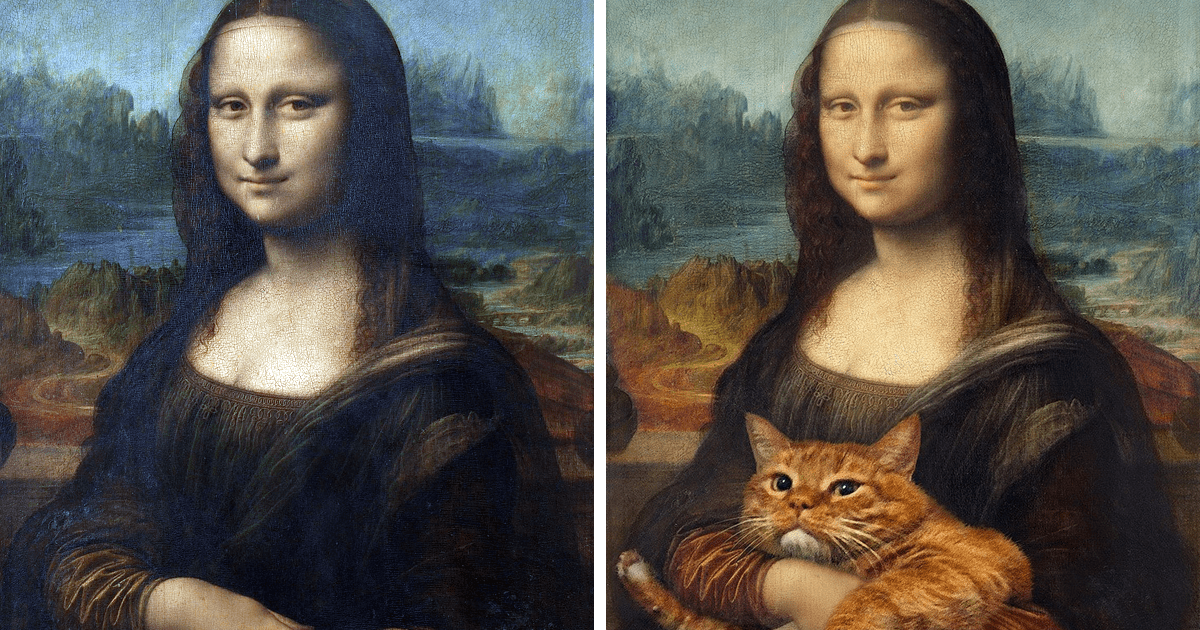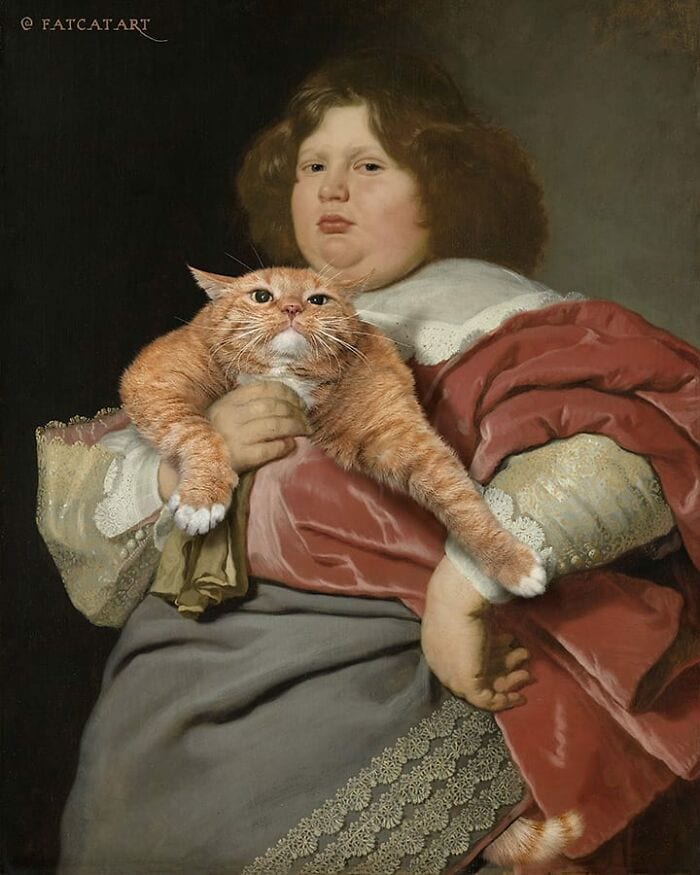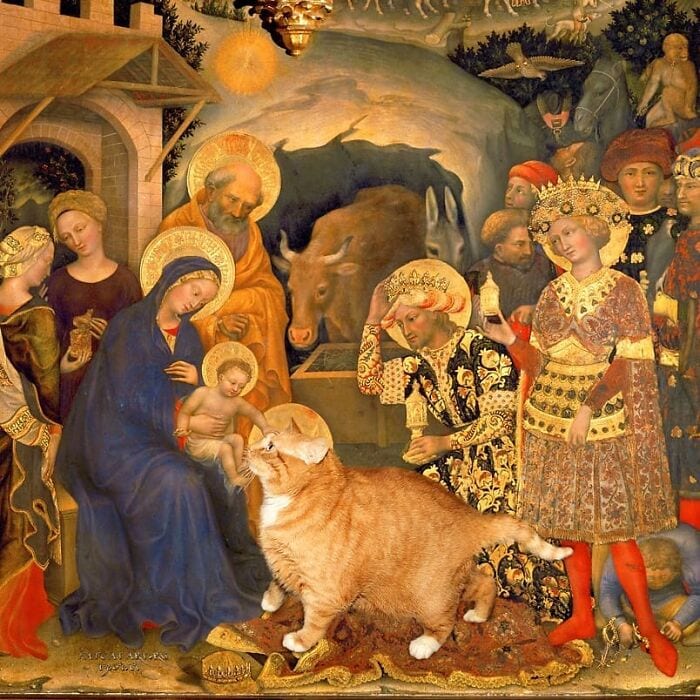

There is a reason Internet is filled with cat pictures, videos, basically anything and everything to do with cats. And it only gets more cat content added to it each and every day. So that is why people are always looking for new and unique things relating to cats. Well, this person definitely found a way to set his ginger cat above the rest. You see, they love to add their cat into famous paintings from the past.
This not only includes the Mona Lisa but also beautiful works by the likes of Picasso. It makes us wonder whether these paintings would have been better if these artists included a cat from the start. But alas, we don’t have to wonder because Svetlana Petrova has done all the work for us. Expertly photoshopping the cat and I must say that it looks breathtaking.
And I will even go as far as to say, they clearly improved the works.
Zarathustra is 15 years old. He is a very sensible and gentle cat, very kind, he adores cuddling and talking to me, or just laying by my side and purring. He adores attention to his person. He hates when I speak on the phone with somebody when he is nearby, he becomes jealous. Sometimes when I work on the computer for hours, he comes to me and asks for attention, just like saying ‘you give me more attention on your computer than in real life!’
Zarathustra has a real talent for acting and being a model. Actually, he is a natural-born artist and he knows he is making art, and he is always very friendly to photographers. He knows who is a photographer and begins to flatter these people—amazing how he knows!
Source: Instagram




Zarathustra is a serious cat and this is a serious project: all our works of art are high-resolution and large-sized, like original paintings, and the aim of the project is to put them for a couple of days or years or centuries in the museums where the original paintings are. We are just waiting to find out what museum would be brave enough to let an internet kitty in.








He has a special place for work as a model. In my apartment there is a podium covered by a big carpet, it looks like a stage. When Zarathustra wants to pose, he shows me that I should go to this place, then lays down on this carpet, and begins to make very funny poses with a very serious face. He has rich mimicking skills and can make different, very expressive faces. Actually, Zarathustra the Cat is a fantastic actor.


Fat Cat Art is a very personal project for me. Zarathustra the Cat is my mother’s cat; I adopted him after she died in 2008. I was so close to my mother, and miss her so much. Zarathustra was and is a living memory of my mother. Zarathustra saved me from depression after my mother’s death. Before in my theatre project, I made artworks with my other cat Marc, and one of my friends told me: “why you don’t do any art with your new cat Zarathustra, he is so funny!”




My digital art pieces come to the real world in different ways: they can be printed with different techniques, and they can be recreated manually, printed on canvas, and then painted, and just painted. So I can show not only digital art online but also exhibit it offline.
For exhibitions, I print an image on canvas for painting, then I make applications of historical pigments overprint—natural mineral colors, such as lapis lazuli, which is the powder of semi-precious stone used to paint the sky and blue colors, lead-tin yellow, and lead white for highlight accents, and touches of true vermillion for Zarathustra’s fur. All these colors were used in Renaissance and Old Dutch paintings, and now they are produced in very small quantities, mainly for restoration needs. Also, I restore brush stroke volume using modern acrylic materials.




I thought: why not, it will amuse me, and began to think of what I should do. It was useless to put wings on him because he is evidently unable to fly in his physical conditions. So I thought that maybe I could do a photo session with food in the style of Dutch still-life paintings. To imagine how it would look, I decided to photoshop the cat into some painting (I used Photoshop for sketches of the sets of my events and costumes).
And I don’t know why I photoshopped it into another painting, Danae by Rembrandt. Then I made 4 more classic paintings, and I sent them to some friends of mine, artists, and gallerists, just to see their reaction. Never before had I seen serious ladies crying to tears and laying down from laughter. This encouraged me a lot






My other inspiration was the internet. I dreamt of creating an internet meme that would be beautiful and clever; this virus should bring some information, some stimulus to know more. People discovering my cat paintings should google the originals. Of course, not all of them do that, but just a few of them doing it is worth a play.
Making this project brought a lot of knowledge for me also: I studied the style of old masters, their technique, to make paintings look as if they are real paintings made by old masters. I am very pleased if a museum that has original paintings in its collection reposts my artworks.


I especially love Italian Renaissance masters like Leonardo, Raphael, Botticelli, northern masters Albrecht Durer, Hieronymus Bosch, Pieter Bruegel the Elder, Peter Paul Rubens, Jan Vermeer and Bartholomeus van der Helst, master of Dutch still-life Willem Claesz Heda and Pieter Claesz, Spanish Diego Velazquez and Francisco de Goya, Salvador Dali (not classical but equal in painting skills), French Jean Auguste Dominique Ingres, Jacques Louis David, Americans John Singer Sargent and Edward Hopper (the last one also not classic), Russian Ilya Repin, Kuzma Petrov-Vodkin, Kazimir Malevich, etc.
What are your thoughts on these new additions? Let us know in the comments below.